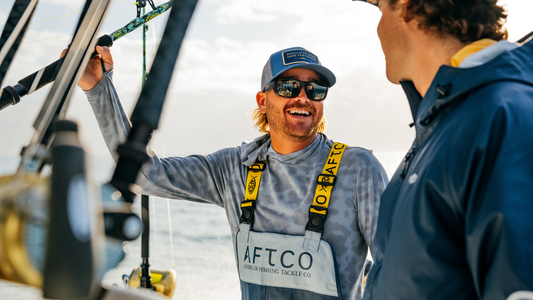
How to Use Forward Facing Sonar
Written By: Dave Rush
In the ever-evolving world of fishing technology, few innovations have stirred the waters quite like forward-facing sonar (FFS). Whether you are a weekend angler or a tournament pro, this revolutionary tech has changed how fish are located, targeted, and caught. But while the benefits are hard to deny, FFS is not without its controversies—especially in competitive settings.
So, what is all the fuss about? In this blog, we'll explain what FFS is, where it came from, why it’s loved (and sometimes hated), and how you can make the most of it on your boat.
Brief History of Forward-Facing Sonar
Forward-facing sonar—also referred to as forward-looking sonar or real-time sonar—first gained mainstream traction with Garmin’s Panoptix LiveScope. What started as grainy, hard-to-decipher images have evolved into incredibly crisp, detailed imaging that allows anglers to make out not just fish but fins, species distinctions, and even how a fish reacts to a lure in real-time.
Today, brands like Garmin, Lowrance, and Hummingbird offer their versions of FFS, each pushing the boundaries of underwater visibility and fishing efficiency. What once seemed like a luxury has quickly become a staple, especially for those chasing serious results.
Learn more about how sonar works from this helpful guide by BoatUS.
The Advantages & Disadvantages of FFS
Like any advanced tool, forward-facing sonar has its pros and cons. Here is a breakdown from both sides of the screen.

Advantages
- Real-Time Viewing: With FFS, anglers don’t have to guess what’s beneath the surface. Anglers can see fish react to their baits live on the screen, allowing them to adjust on the fly.
- Efficiency Boost: Anglers can eliminate unproductive casts. Instead of blind casting, anglers can target specific fish and learn patterns faster.
- Access to Suspended Fish: Fish suspended in open water—once impossible to consistently target—are now within reach, making offshore and deep-water fishing more accessible.
- Pattern Recognition: FFS helps anglers quickly determine behavioral patterns and adjust presentations, accordingly, shortening the learning curve on any body of water.
“Forward-facing sonar has completely changed the way I fish offshore. I can now see fish I never would have found before,” says AFTCO Pro Jeremy Lawyer.
Disadvantages
- Cost: Outfitting a boat with high-end FFS can cost thousands of dollars. With new models released frequently, it is easy to feel like your tech is outdated within a season.
- Learning Curve: While powerful, FFS is not plug-and-play. It takes time and effort to master interpreting what you are seeing on-screen.
- Head Down Syndrome: Many anglers find themselves glued to the screen, missing the joy of their surroundings or even risking their safety on the water.
- Tournament Debate: There is an ongoing discussion about whether FFS creates an uneven playing field, especially when some competitors cannot afford it.
Pro Tips & On-the-Water Experience
The pros agree—FFS is here to stay. But how anglers use it can make or break your success. Many pros suggest practicing on small lakes or ponds to understand how fish appear on your screen in various situations.
“Like any fishing technique there is no substitute for time on the water, when you are trying to learn. Forward-Facing Sonar is no exception to that rule. I spend a lot of time in my off-season chasing Crappie with my Garmin Livescope and it has been super beneficial,” says Lawyer.
If you are competing, most pros recommend keeping your head up and remembering that sonar is just a tool. It does not replace fishing instinct—it enhances it.
Tuning Your FFS: Settings That Matter
FFS settings are highly customizable; what works for one angler may not work for another. Here are the key settings you’ll want to tweak based on your style, water clarity, and personal preferences:
Gain
- Controls how much detail shows on the screen.
- Higher gain = more detail, but also more clutter.
- Aim for a balanced setting to clearly see fish without excess sediment.
Depth Range
- Use “auto” for general fishing or adjust based on the depth you are targeting.
- Shallower water? Decrease the range to increase detail and make fish easier to spot.
Forward Range
- Determines how far out in front of your boat you can see.
- Start at 100 feet. Adjust for species, water clarity, and target distance.
Color Palette
- Choose based on visibility and water conditions.
- Some anglers prefer moss green for cover and blue for open water.
- Choose a palette where you can clearly see your lure.
Focus
- Referring to the alignment of the three lenses in a Livescope transducer.
- Auto adjusts, but manual tweaking can help you get better clarity across the screen.
Noise Rejection
- Filters out clutter from sediment or debris.
- Set to medium or high and leave it there to keep your screen clean.
TVG (Time Variable Gain)
- Filters out nearby clutter to help you see deeper.
- Turn it off when fishing shallower than 20 feet to avoid losing surface details.
For a complete guide on budget-friendly FFS setups, check out this resource from Wired2Fish.
Top Forward-Facing Sonar Brands
When choosing an FFS unit, three brands dominate the market. Each has its strengths and loyal following:

Garmin
- Known for pioneering Panoptix LiveScope, Garmin continues to set the bar with excellent real-time imaging and robust hardware.
-
Learn more about LiveScope technology here.
Humminbird
- Offers MEGA Live Imaging with high-resolution performance.
- Strong ecosystem integration with other Humminbird and Minn Kota devices.
Lowrance
- ActiveTarget delivers reliable sonar with smart target tracking features.
- Especially popular with tournament anglers who value precise control and multi-angle viewing.
Pro Tip: Before buying, visit a local shop or boat show to demo these units. What looks good on paper sometimes does not match how your eyes process it on the water.
Whether you see forward-facing sonar as the future of fishing or just another tool in the tackle box, there is no denying its impact. It brings unmatched clarity to the underwater world, helping anglers become more strategic, efficient, and successful.
But like any tool, how you use it makes all the difference. Master your settings, trust your instincts, and keep your eyes on the water—not just the screen.
Author's Profile: Dave Rush
Dave Rush is a veteran outdoor writer and photographer who has worked in the fishing industry since 2009. As Editor in Chief of Best On Tour, he brings over a decade of experience and a deep passion for telling the stories behind the sport.






